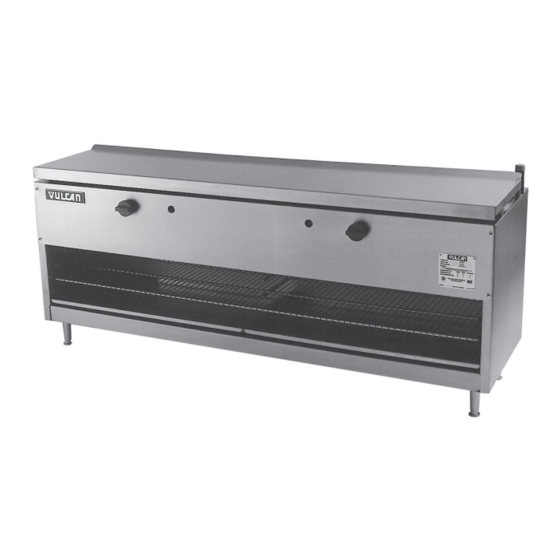Advertisement
Quick Links
ICM24,36,48,60 AND 72 CHEESE MELTERS
MODEL NO.
ICM24
ICM36
ICM48
ICM60
ICM72
V U L C A N - H A R T C O M P A N Y , P . O . B O X 6 9 6 , L O U I S V I L L E , K Y 4 0 2 0 1 - 0 6 9 6 , TEL. (502) 7 7 8 - 2 7 9 1
FORM 30915 (3-95)
ML-52470, 52476
ML-52471, 52477
ML-52472, 52478
ML-52473, 52479
ML-52474, 52480
SERVICE MANUAL
MODEL ICM
Advertisement

Summary of Contents for Vulcan-Hart ICM24
- Page 1 ICM24,36,48,60 AND 72 CHEESE MELTERS MODEL NO. ICM24 ML-52470, 52476 ICM36 ML-52471, 52477 ICM48 ML-52472, 52478 ICM60 ML-52473, 52479 ICM72 ML-52474, 52480 V U L C A N - H A R T C O M P A N Y , P . O . B O X 6 9 6 , L O U I S V I L L E , K Y 4 0 2 0 1 - 0 6 9 6 , TEL. (502) 7 7 8 - 2 7 9 1...
-
Page 2: Important For Your Safety
IMPORTANT FOR YOUR SAFETY THIS MANUAL HAS BEEN PREPARED FOR PERSONNEL QUALIFIED TO INSTALL GAS EQUIPMENT, WHO SHOULD PERFORM THE INITIAL FIELD START-UP AND ADJUSTMENTS OF THE EQUIPMENT COVERED BY THIS MANUAL. POST IN A PROMINENT LOCATION THE INSTRUCTIONS TO BE FOLLOWED IN THE EVENT THE SMELL OF GAS IS DETECTED. - Page 3 Section lll Trouble Shooting CODES AND STANDARDS Vulcan-Hart Cheese Melters are to be installed in accordance with state and local codes, or in the absence of local codes, with the National Fuel Gas Code, ANSI-Z223.1 (latest edition), available from the American Gas Association, Inc., 1515 Wilson Blvd., Arlington, Va.
- Page 4 SECTION I SERVICE CHECKS AND ADJUSTMENTS WARNING: SHUT OFF GAS BEFORE SERVICING VENTILATION CHECKS Insure that adequate ventilation has been provided in accordance to all codes as stated on page 3 of this manual. The vent for this appliance should be checked for restrictions every 6 months. GAS SUPPLY CHECKS If the gas supply piping is to be tested at a test pressure in excess of individual shut-off valve must be disconnected from the supply line.
- Page 5 PILOT ORIFICE HOOD CHECK 1. Follow steps 1-3 under Removal of Lighter Tube. 2. With a ⁄ " wrench remove the orifice hood. 3. Examine the hood and orifice opening for blockage. 4. If blockage is found, remove it using air or water pressure. 5.
- Page 6 SECTION II REMOVAL OF SERVICE PARTS WARNING: SHUT OFF GAS BEFORE SERVICING. REMOVAL OF TOP 1. Push top back towards wall until the rear top mounting foot hits the stop angle. (Fig. 2) STOP ANGLE 2. Be sure that the top mounting foot has cleared the front top flange and lift the top off of the appliance.
- Page 7 REMOVAL OF BURNER VALVE 1. With a small blade screwdriver loosen the set screw in the valve knob and remove the knob. 2. With a phillips head screwdriver remove (4) screws at each corner of the front panel and remove the panel. (Fig. 4) 3.
- Page 8 4. Disconnect the valve from the manifold pipe. (See Fig. 5) NOTE: It may be necessary to remove heat shield to disconnect the valve. 5. Install new valve using pipe dope and reversing steps 1-4. REPLACEMENT OF PILOT ADJUSTMENT VALVE 1.
- Page 9 4. Install new pilot valve using pipe dope and reversing steps 1-3. REMOVAL OF BURNER 1. Follow steps 1-2 under Removal of Top. 2. With a ⁄ " wrench remove (2) nuts. (Figs. 8) 3. Lift the burner mounting bracket off the appliance. (Figs. 8) 4.
- Page 10 BURNER NOZZLE REPLACEMENT 1. To remove the burner nozzle follow steps 1, 2 and 3 under Burner Nozzle Orifice Check. (Fig. 10) Fig. 10 2. Install new nozzle by reversing steps 1, 2, and 3 under Burner Nozzle Orifice Check. —...
- Page 11 REMOVAL OF PILOT LIGHTER VALVE 1. Follow steps 1-3 under Removal of Pilot Lighter Tube. 2. With a ⁄ " wrench disconnect valve fitting from the pilot tube. (Figs. 11) LIGHTER TUBE 3. Install new valve fitting and ferrule by reversing steps 1 and 2 above. REMOVAL OF PILOT LIGHTER TUBE 1.
- Page 12 SECTION lll TROUBLE SHOOTING Uneven heating, sides burning To much top heat Uneven heat side to side Uneven heat front to back Dried out products Pilot outage Poor ignition FORM 30915 (3-95) A) Temperature too low. B) Improper operation of broiler. C) Fluctuating gas pressure.
















Need help?
Do you have a question about the ICM24 and is the answer not in the manual?
Questions and answers